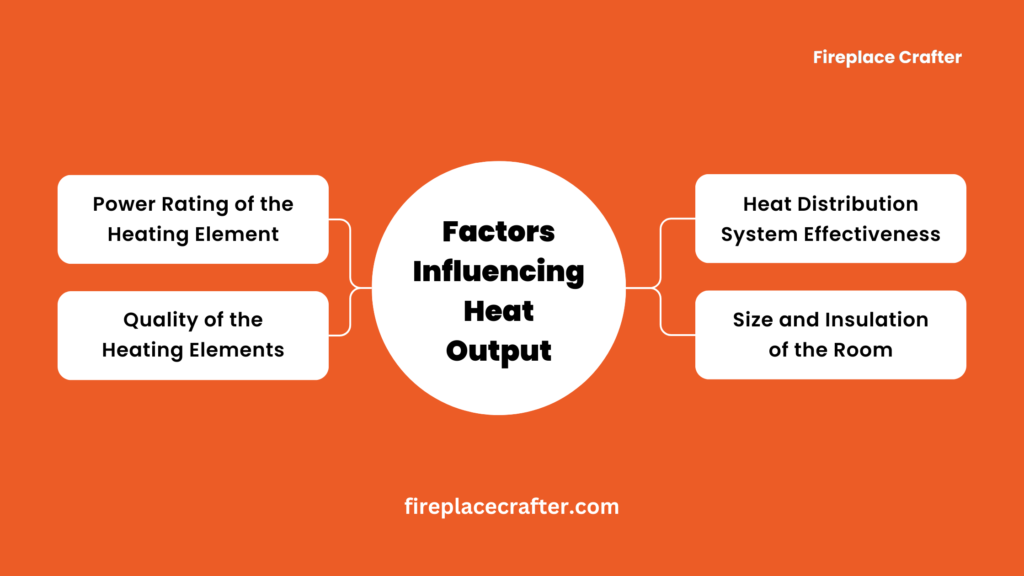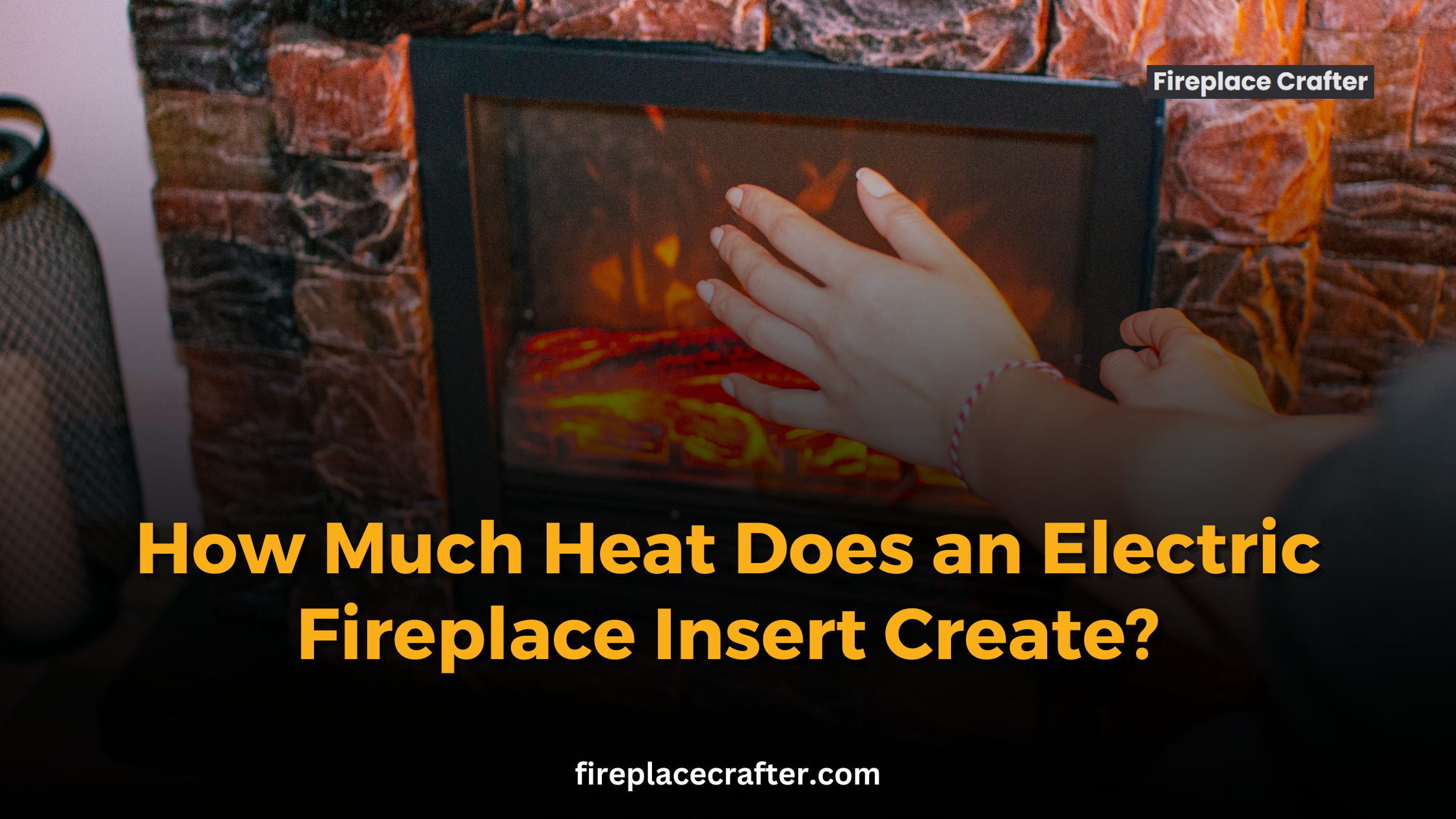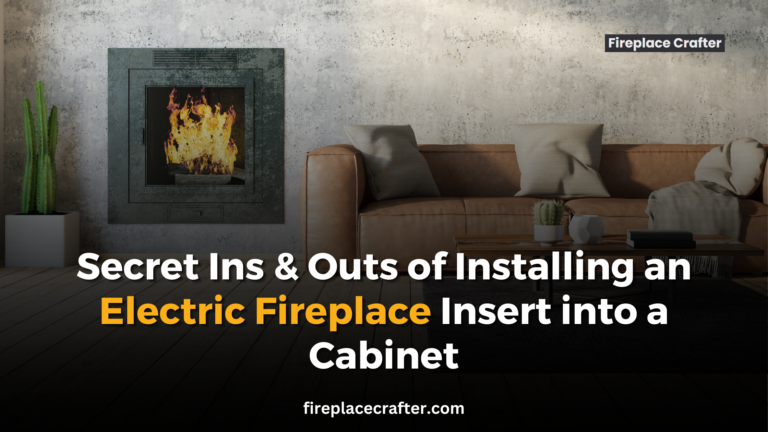How Much Heat Does an Electric Fireplace Insert Create?
As the chill of winter takes hold and you’re dreaming of cozy evenings by the fire, the practicalities of installing a traditional fireplace might feel overwhelming. Luckily, electric fireplace inserts are here to provide a warm, inviting, and aesthetically pleasing alternative.
But just how much heat do these modern marvels generate? Are they enough to replace your home’s central heating, or are they just pretty showpieces?
This blog post focuses to shed some light on the burning question: how much heat does an electric fireplace insert create? With comprehensive information, we’ll guide you through these stylish home heating solutions’ heat output, energy efficiency, and overall benefits.
Brief Introduction to Electric Fireplace Inserts
In recent years, electric fireplace inserts offer the charm of a traditional fireplace with modern convenience. Powered by electricity, these advanced heating systems replicate the appearance and ambiance of a traditional fireplace while generating comforting heat
Designed to fit seamlessly into existing fireplaces or custom-built mantels, electric fireplace inserts provide versatility for different settings and preferences.
Why Understanding Heat Generation in Electric Fireplace Inserts Matters?
For several reasons, understanding the mechanics of heat generation in electric fireplace inserts is critical.
- Optimizing Energy Efficiency and Heating Capabilities: Electric fireplace inserts can assist users in maximizing the energy efficiency of their devices, ultimately resulting in potential cost savings on electricity bills.
- Safety Measures: Understanding the heat generation process of electric fireplace inserts can help users implement proper safety measures, reducing the risk of accidents caused by misuse.
- Heat Generation Mechanism: Delving deeper into the topic, we will explore the detailed mechanism by which electric fireplace inserts generate heat.
- Advantages: Our article will also highlight the various advantages electric fireplace inserts offer, providing a comprehensive understanding of their benefits.
- Innovative Technology: We will uncover the innovative technologies employed in operating electric fireplace inserts, showcasing the modern advancements in this field.
Basic Principles of Heat Generation
Gain a fundamental understanding of how heat is generated in electric fireplace inserts by exploring the principles of electric heating, resistance, and energy conversion for a comprehensive grasp of their inner workings.
Understanding the Principles of Electric Heating
The principle of electric heating is at the core of an electric fireplace insert’s heat generation. This is a process in which electrical energy is transformed into heat energy. The device utilizes electric resistors that adhere to Joule’s first law.
This statement asserts that the heat generated by a current passing through an efficient conductor is equal to the square of the electric current, the resistance of the conductor, and the duration of the current.
In simpler terms, when electricity passes through a resistant material (the heating element), the friction created generates heat. This heat is then distributed throughout the room, providing a comfortable, warm environment.
The Role of Resistance in Heat Generation
Resistance plays a pivotal role in the heat generation of an electric fireplace insert. The heating element in the insert is made of a highly resistive material, which impedes the flow of electricity.
As current tries to pass through this high resistance, the struggle or friction generates heat. This heat, once produced, is propelled into the room by a fan or through radiation, depending on the type of fireplace insert.
The careful management of this resistance allows electric fireplace inserts to produce heat efficiently and safely, and it is one of the crucial and key factors influencing the amount of heat the fireplace insert can produce.
The Principle of Energy Conversion in Electric Fireplace Inserts
Electric fireplace inserts embody energy efficiency, converting nearly all input electricity into heat. The conservation of energy principle facilitates this conversion, transforming electricity from the home’s power supply into heat through the insert’s heating element.
This heat creates a cozy environment and is fully utilized within the room, enhancing efficiency, unlike traditional fireplaces, where heat often escapes through the chimney.
Applying these heat generation principles manifests itself in two primary heating technologies: convection and infrared. As we dive deeper into electric fireplace inserts’ operations, we’ll examine how these technologies contribute to their effectiveness.
Heat Output of Electric Fireplace Inserts
Discover the range and factors influencing the heat output of electric fireplace inserts, empowering you to make informed decisions about selecting the ideal level of warmth for your home.

Standard Heat Output Ranges
The heat output of electric fireplace inserts typically falls within a certain range, with most units able to produce between 4,000 and 5,000 British Thermal Units (BTUs) per hour. This range is sufficient to heat a room of about 400 to 500 square feet, making electric fireplace inserts a practical choice for many living spaces. Nevertheless, this can vary depending on the model and the power of the heating element used.
It’s essential to note that, unlike traditional fireplaces, electric fireplace inserts can also operate without emitting heat, allowing users to enjoy the visual effect of the flames without raising the room’s temperature—a feature particularly appreciated in warmer months.
Unit of Measurement for Heat Output (BTUs)
The heat output of electric fireplace inserts is typically measured in British Thermal Units (BTUs) per hour. A British Thermal Unit (BTU) represents the heat quantity necessary to increase the temperature of a pound of water by one degree Fahrenheit. This measurement helps determine the unit’s heating capacity and allows for comparisons between different models.
When selecting an electric fireplace insert, it is essential to consider the heat output in BTUs to ensure the unit will adequately heat the intended space. As a rule of thumb, approximately 20 BTUs per square foot are required for efficient heating. However, this number varies depending on factors like the insulation and ambient temperature of the room.
Optimizing the Heat Output of an Electric Fireplace Insert
Learn practical tips and techniques to maximize the heat output of your electric fireplace insert, ensuring a warm and inviting ambience in your living space.
Regular Maintenance and its Impact on Heat Output
Electric fireplace inserts require regular maintenance to maintain optimal performance and efficiency, just like any other device. Eventually, dust and dirt can accumulate on the heating elements and fans, reducing their effectiveness and, subsequently, the heat output.
Regularly cleaning the fireplace insert, as guided by the manufacturer’s instructions, can help maintain its efficiency. This often involves dusting the interior and exterior of the unit and occasionally vacuuming out any debris.
Best Practices for Maximum Heat Output
To get the maximum heat output from your electric fireplace insert, consider the following best practices:
1. Placement: Position the fireplace insert in a central location to ensure the heat is evenly distributed across the room. Always avoid placing the unit near windows or doors where drafts could cause heat loss.
2. Use of the Thermostat: Many electric fireplace inserts have a built-in thermostat. Using this can help regulate the heat output based on your comfort level, ensuring that the insert is not using more power than necessary.
3. Suitable Model: Choose a model with a heat output suitable for the size of your room. A model with a higher BTU output will heat a larger room more effectively.
The Role of Insulation in Retaining Heat
Even the most efficient electric fireplace insert will struggle to heat a room that is not well insulated. Insulation plays a crucial role in retaining the heat generated by the insert, thereby optimizing its performance.
Good insulation ensures the heat generated stays within the room and doesn’t escape through walls, ceilings, or drafts from windows or doors. Therefore, ensure the room is well insulated before installing an electric fireplace insert. If not, consider improving the insulation to make the heating process more efficient.
By implementing these practices, you can optimize the heat output of your electric fireplace insert, ensuring that your living spaces are comfortably warm and inviting.
Current Innovations in Electric Fireplace Insert Technology
Explore the latest advancements in electric fireplace insert technology, from cutting-edge features to enhanced efficiency, shaping the future of cozy home heating.

Advances in Heat Generation and Distribution Technology
Recent innovations in electric fireplace insert technology have focused on enhancing the heat generation and distribution processes. Infrared technology, for instance, has seen wider application in newer models.
Infrared heaters warm up objects and people directly instead of heating the air, which makes them incredibly efficient and allows for a nearly instantaneous warmth that conventional heating coils can’t provide.
Regarding distribution, some models now incorporate advanced fan systems that distribute heat more evenly across the room. These systems can often be adjusted to suit the user’s preferences, ensuring the heat reaches all parts of the room.
Efficiency Improvements in Recent Models
Modern electric fireplace inserts are becoming increasingly energy-efficient. Features like programmable thermostats, adjustable heat settings, and auto shut-off functions help reduce unnecessary power consumption, thereby improving efficiency.
Some models are also designed to minimize standby power usage when the insert is not heating actively, reducing energy consumption.
Upcoming Trends in Electric Fireplace Inserts
Moving forward, we anticipate further advancements enhancing the efficiency, utility, and visual allure of electric fireplace inserts. One exciting trend is the integration of smart technology, allowing users to control their fireplace inserts using smartphone apps or voice-activated devices. This will offer users greater control over the heating function and increase energy efficiency.
Factors Influencing Heat Output
Several factors can influence the heat output of an electric fireplace insert. These include:

Power Rating of the Heating Element:
The power rating of the heating system element is one of the most critical factors. A higher power rating generally equates to a higher heat output. However, this also means higher electricity consumption.
Quality of the Heating Elements:
The quality of the heating elements can also significantly impact the heat output. Superior elements will convert electricity into heat more efficiently, providing a higher heat output for the same amount of electricity consumed.
Heat Distribution System Effectiveness:
This wasn’t explicitly mentioned in your initial text, but it can be inferred that the effectiveness of the heat distribution system plays a role in determining the heat output.
Size and Insulation of the Room
Finally, the heated room’s size and insulation also play crucial roles. Larger, poorly insulated rooms will require more heat to maintain a comfortable temperature, which might be beyond the capacity of some electric fireplace inserts.
Conclusion
This article delves into the heat generation process in electric fireplace inserts, including electric heating, resistance, and energy conversion principles. Now you have a complete answer to how much heat an electric fireplace insert creates. Make sure you’re equipped with heat output ranges, factors influencing them, and tips for optimizing.
Safety considerations and innovations in electric fireplace insert technology are discussed. Understanding heat output is crucial for efficiency, safety, and informed purchasing decisions.
Electric fireplace inserts offer a cozy and efficient solution for creating a warm home environment.







